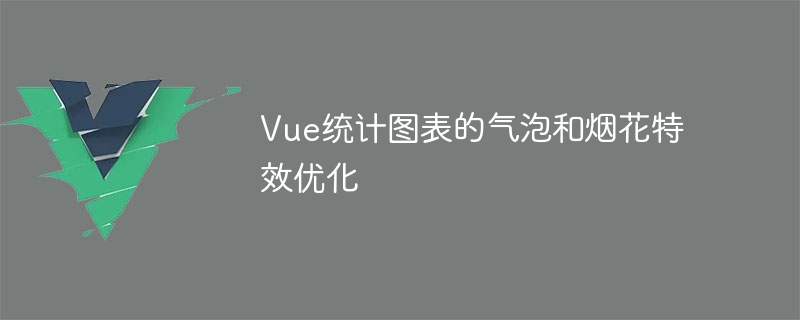

Optimization of bubbles and fireworks special effects in Vue statistical charts
Introduction:
With the rapid development of the mobile Internet, data visualization has become one of the important means of displaying data. one. In data visualization, statistical charts can not only display data concisely, but also improve user experience. In the Vue framework, by using plug-ins and components, we can quickly implement various statistical charts, and optimize them to make them more vivid and attractive. This article will take bubble charts and fireworks effects as examples to introduce how to optimize the presentation of statistical charts in Vue.
1. Vue Bubble Chart Optimization
Bubble chart is a statistical chart that uses the size and position of circular bubbles to display data. In Vue, we can use the ECharts plug-in to quickly implement the bubble chart and make it more vivid and intuitive through some optimization methods.
<template>
<div id="bubble-chart"></div>
</template>
<script>
import echarts from 'echarts'
export default {
mounted() {
this.renderChart()
},
methods: {
renderChart() {
const chart = echarts.init(document.getElementById('bubble-chart'))
const option = {
series: [
{
type: 'scatter',
symbolSize: function (data) {
return Math.sqrt(data[2]) * 5 // 根据数据动态调整气泡大小
},
data: [
[10.0, 8.04, 10],
[8.0, 6.95, 12],
[13.0, 7.58, 6],
[9.0, 8.81, 8],
[11.0, 8.33, 16],
[14.0, 9.96, 10],
[6.0, 7.24, 12],
[4.0, 4.26, 18],
[12.0, 10.84, 8],
[7.0, 4.82, 14],
[5.0, 5.68, 20]
],
}
]
}
chart.setOption(option)
}
}
}
</script>
<style scoped>
#bubble-chart {
width: 400px;
height: 300px;
}
</style>In the above code, we use the symbolSize parameter to set the size of the bubble, and use the calculation method of Math.sqrt(data[2]) * 5 to make the size of the bubble The radius is proportional to the third dimension in the data. In this way, when the data changes, the size of the bubble will also change accordingly.
The following is a simple transition effect sample code:
<template>
<transition name="bubble-fade">
<div id="bubble-chart"></div>
</transition>
</template>
<script>
import echarts from 'echarts'
export default {
mounted() {
this.renderChart()
},
methods: {
renderChart() {
const chart = echarts.init(document.getElementById('bubble-chart'))
// 省略其他代码
// 监听图表变化并重新渲染
this.$watch('chartData', () => {
chart.setOption(this.chartData)
})
}
},
data() {
return {
chartData: {
series: [...]
}
}
}
}
</script>
<style scoped>
.bubble-fade-enter-active, .bubble-fade-leave-active {
transition: opacity 0.5s;
}
.bubble-fade-enter, .bubble-fade-leave-to {
opacity: 0;
}
</style>In the above sample code, we added the transition component to the div container and specified a bubble-fade Transition effects. At the same time, we monitored changes in chartData, re-rendered the chart when the data changed, and added a smooth effect when switching charts through transition effects.
2. Vue Fireworks Special Effects Optimization
Fireworks special effects are often used in data visualization to emphasize certain data or give users a better visual experience. In Vue, we can use the Particles.js plug-in to quickly implement fireworks effects and make them more cool and beautiful through some optimization methods.
<template>
<div id="fireworks"></div>
</template>
<script>
import Particles from 'particlesjs'
export default {
mounted() {
this.initParticles()
},
methods: {
initParticles() {
Particles.init({
selector: '#fireworks',
maxParticles: 100, // 粒子数量
sizeVariations: 5, // 粒子大小变化范围
speed: 2, // 粒子运动速度
color: '#fff', // 粒子颜色
connectParticles: true // 是否连接粒子
})
}
}
}
</script>
<style scoped>
#fireworks {
width: 400px;
height: 300px;
}
</style>In the above code, we specify the number of particles as 100 and adjust the size variation range of the particles through the sizeVariations parameter. We can also adjust parameters such as speed and color to achieve different fireworks effects. By appropriately adjusting these parameters, we can get cooler and more exquisite fireworks effects.
<template>
<div :id="'fireworks-' + screenType"></div>
</template>
<script>
import Particles from 'particlesjs'
export default {
mounted() {
this.initParticles()
this.$nextTick(() => {
window.addEventListener('resize', this.resizeHandler)
})
},
beforeDestroy() {
window.removeEventListener('resize', this.resizeHandler)
},
methods: {
initParticles() {
Particles.init({
selector: `#fireworks-${this.screenType}`,
// 其他配置参数
})
},
resizeHandler() {
if (window.innerWidth < 768) {
this.screenType = 'mobile'
} else {
this.screenType = 'desktop'
}
}
},
data() {
return {
screenType: ''
}
}
}
</script>
<style scoped>
#fireworks-mobile {
width: 300px;
height: 200px;
}
#fireworks-desktop {
width: 400px;
height: 300px;
}
</style>In the above sample code, we dynamically change the size and position of the fireworks effects according to changes in screen size by listening to the resize event. By setting different screenTypes, we can display different sizes of fireworks effects on devices of different sizes.
Summary:
This article introduces how to optimize the presentation of Vue statistical charts by optimizing code and adding transition effects. By dynamically updating the bubble size and position, and adding transition effects, we can make the bubble chart more vivid and attractive. At the same time, through custom particle effects and responsive design, we can make the fireworks effects more cool and beautiful. I hope readers can better optimize the presentation of Vue statistical charts and improve user experience through the introduction of this article.
The above is the detailed content of Optimization of bubbles and fireworks special effects for Vue statistical charts. For more information, please follow other related articles on the PHP Chinese website!